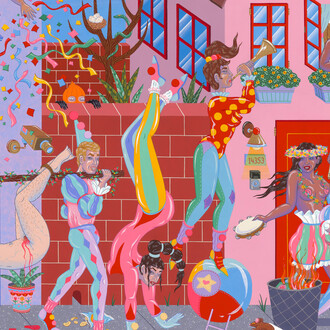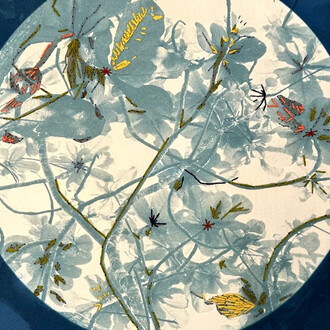Ben Sakoguchi’s Potus, Massas and survivors, an exhibition of works ranging from the 1980s to the present, satirically probes the power structure in America. The centerpiece of this show, Great American Massas (2008), is an assemblage of fifteen canvases juxtaposing past presidents with African American cultural figures that have risen to prominence against the odds. Deployed as orange crate labels, the vivid compositions call to mind California’s most famous export, sweetening his critique of what it means to be a leader in America. Great American Massas is presented along with All-American football (1981-82), Air force one (1982), and a selection of works from the Orange crate label series (1970 – present).
“Well, I’ve always been interested in history, even when I was a kid”, Sakoguchi recalls. Born in San Bernardino in 1938, of Japanese descent, at the age of three Sakoguchi was sent with his family to an internment camp in Poston, Arizona. “I was so curious about what happened there, but I couldn’t find even a mention of it in the history books until I was in my late teens. And for much of my life—until fairly recently—the real story of slavery and about the achievements of African Americans has also been missing from the accepted history of this country”.
Since the 1970s Sakoguchi has exhibited his incisive works in university and non-profit galleries; more recently his depictions of American history have provoked discourse in major museums across the country, from The Hammer in Los Angeles, to the Museum of Modern Art in New York City, to the Smithsonian in Washington, DC.
Great American Massas (2008) highlights the twelve U.S. presidents that owned slaves. They hail from the founding to Reconstruction, which in this piece Sakoguchi has renamed Deconstruction. He remarks, “I don’t want to necessarily un-hero them, but they also had this side to them that you have to watch out for”. These venerated figures, posing in their finery and military jackets, are surrounded by famous African Americans–from Frederick Douglass to BB King to Oprah Winfrey–who somehow managed to achieve greatness on their own terms. Sakoguchi’s enticing graphic style dramatizes the wasteful absurdity of suppressing the contributions of any oppressed group. He makes the point with trademark humor, for example, displaying George Washington with five famous African Americans with that same last name, including Booker T. and Denzel. On another panel, the notorious Andrew Jackson is pictured in Jackson Five Brand with five stages of Michael Jackson.
All-American football (1981-82) features four modern American presidents in football jerseys. The series displays the iconic image of each future leader in his youth robustly striding forth on a straightforward path to greatness. In contrast, the portrait of Paul Robeson with a pigskin under one arm seems less self-assured and more pensive, as if this young hero with such exceptional talents really doesn’t know if he’ll succeed or get crushed by the system.
Air force one (1982) depicts nine presidents, from Franklin Roosevelt to Ronald Reagan, with their presidential aircraft. Each plane has a “nose-art” style name that contains a wry comment; FDR’s is called Executive Sweet, and is stamped with "I love Lucy", a reference to his mistress Lucy Mercer Rutherford, previously Eleanor’s social secretary. In this series of sly tableaus Sakoguchi correlates an obnoxious symbol of unassailable male leadership with their storied foibles; Lyndon B. Johnson, in front of the Ladybird, is blithely showing off his appendectomy scar: not a war wound but the mark of a minor surgery. In 1975 on a diplomatic trip to Austria Gerald Ford took a tumble at the bottom of the airplane steps; in this work, the famous fall takes place in front of the Miss Fire,Sakoguchi’s succinct reminder of the two assassination attempts against him that took place that same year. In every scenario, the camera snap of American prowess–the president and his plane–is undermined by allusions to their ordinary human weaknesses as they attempt to fulfill the demands of leadership, and oftentimes fail.
Sakoguchi believes this show has a message for today. This backward glance at America reveals what we’re voting for and against in November: democracy for all, versus a well-established power grab reinforced by racism. The artist remarks, “Back then you couldn’t be both, you couldn’t be an abolitionist and own slaves. It’s like the Union song: “‘Which side are you on?’ The line is there with this presidential election. It couldn’t be clearer”.
Ben Sakoguchi (b. 1938, San Bernardino, CA) lives and works in Pasadena. He received his BFA and MFA from UCLA and taught at the Art Department at Pasadena City College until his retirement in 1997. He has exhibited solo projects at Standard (Oslo), Oslo (2024); Ortuzar Projects, New York (2023); Galerie GP & N Vallois, Paris (2023); Bel Ami, Los Angeles (2021); Ortuzar Projects, New York (2020), POTTS, Alhambra (2018); The Skirball Center, Los Angeles (2016); The Alternative Museum, New York (1992); and San Francisco Fine Arts Museum, San Francisco (1980). His work has been featured in institutional surveys and group exhibitions including Get in the Game, San Francisco Museum of Modern Art (2024); Ordinary people: photorealism and the work of art since 1968, The Museum of Contemporary Art, Los Angeles (2024); No prior art: illustrations of inventions, PST ART, Library Foundation of Los Angeles and Los Angeles Public Library (2024); ¡Pleibol! In the barrios and the big leagues, California Museum, Sacramento (2024); footnotes and headlines, Andrew Kreps Gallery, New York (2021); Landscape, Derosia, New York (2021); L.A. RAW: abject expressionism in Los Angeles, 1945–1980, Pasadena Museum of California Art, Pasadena (2012); Sub-pop, Cardwell Jimmerson Contemporary Art, Los Angeles (2011); Made in California: art, image, and identity, 1900-2000, Los Angeles County Museum of Art, Los Angeles (2000); and The decade show: frameworks of identity in the 1980s, The New Museum, The Museum of Contemporary Hispanic Art, and The Studio Museum, New York (1990). He was twice awarded fellowships by the National Endowment for the Arts.
















